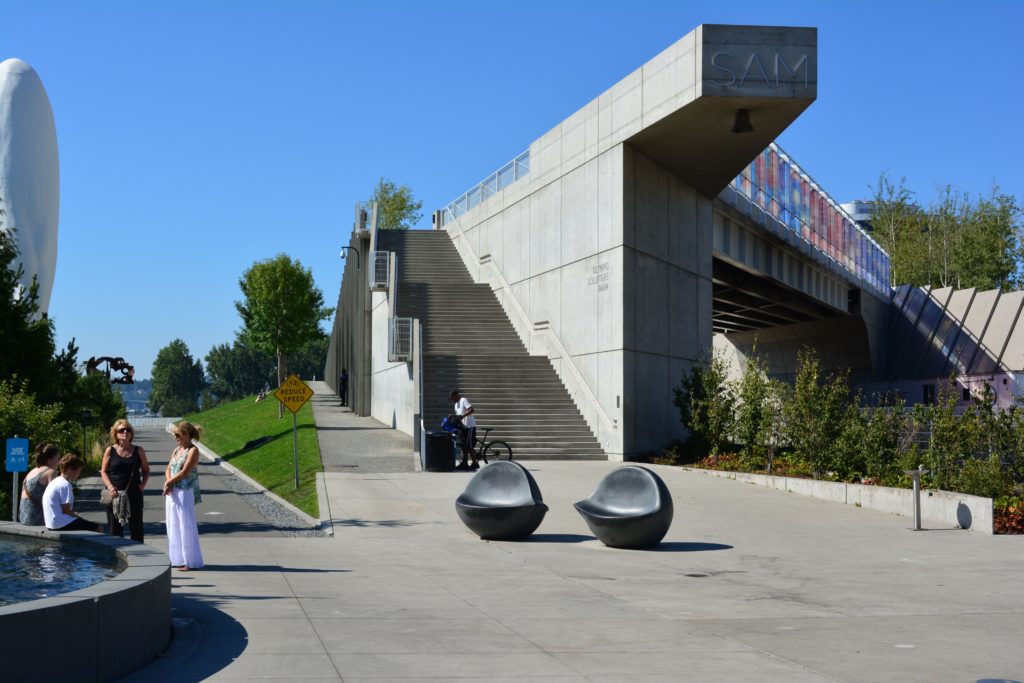
Architect
Charles Anderson Landscape Architects and Architecture Design Team
Type of Area
Bay
Land/water interaction
Riprap
Promenade
Built Environment Types
Completely built
Scale of Impact
District/ neighbourhood
City
Regional
Intervention Scale (Spatial)
Moderate site
Project Types
Urban waterfront development
Cultural regeneration
Public green space regeneration
Urban/ Rural
Inner urban area
Visibility and Openness
Partly enclosed
Part horizon
Perception and Meaning
Imageability
Accessibility
Place identity
Knowledgeability
Health and Wellbeing
Increased physical activities
Restorativeness
Aesthetic experience
Increases socialisation
Interaction with Water
Visual
Tactile – touching
A Sculpture Park with Dramatic Views
The Olympic Sculpture Park is situated in Seattle and offers dramatic views across Elliott bay to the Olympic Mountains and the Puget Sound. It was designed to rejuvenate the urban waterfront and provide a distinctive setting for urban sculpture as part of the Seattle Art Museum development project.
The remediation process of the former industrial area involved capping the contaminated site with up to 12m of compacted and engineered soil to provide a base for the pedestrian infrastructure. The Z-shaped access route is central to the design and creates a dynamic green link to the water from the city connecting three separate parcels of land.
The Z-shaped route takes visitors from the hilltop steel and glass pavilion along the zigzag pathway to the shoreline garden over existing city infrastructure, linking the urban centre to the waterfront. The pedestrian route is divided into three characteristic landscape zones:
A temperate evergreen forested valley
A grove of native deciduous trees adapted to the urban location
A shoreline terraced garden
The pedestrian route also interweaves sculptures and other artwork into the folded landforms and allows visitors to experience art in an outdoor setting which itself has evolved as the vegetation grows and matures. The artwork consists of permanent and temporary installations both outdoors and indoors in the pavilion. As well as providing space for artwork, the pavilion is a venue for performances and educational programmes.
The shoreline is reinforced with riprap and a concrete seawall to reduce erosion and to allow people to get close to the water. The terraces behind the seawall create a multi-layered rainwater catchment system which provides irrigation for the Mark Dion Vivarium, a focal point within the park. Other sustainable features include rocks and logs on the shoreline to encourage the growth of seaweed, such as sea kelp and to provide a habitat for salmon.

Website of the project:
http://www.weissmanfredi.com/project/seattle-art-museum-olympic-sculpture-park
Google map reference
The ratings show that overall, accessibility is excellent. It is rated slightly lower for site visibility as the site goes over infrastructure and weaves its way down to the shoreline, making visibility of the whole site difficult. There is also no entrance fee for the park, however there is an entrance fee for the museum. The site design is good but lacks a cultural heritage focus linked to the water as the industrial remains caused pollution and offered no value.
The range of facilities is rated lower, but this is only to be expected as a site designed to promote movement from one area to another and because facilities are also available close by. The quality of nature, however, is high due to the range of habitats included in the overall design. Although the site creates a place for contemplation in a busy city-centre location by providing seating in a green space, the sense of being away is only average due to its location and parts of it being above a noisy highway.
The project links the city to the water but the focus is on providing space for artwork and not on promoting access to the waterfront, hence the accessibility to the water itself is low and there is little scope for physical activities. The winding nature of the construction also limits the connectivity of the land to the water but makes the best use of the space in an otherwise cluttered environment. The site has created a bridge from the city to the waterfront, but accessibility and interaction with the water could be improved.
